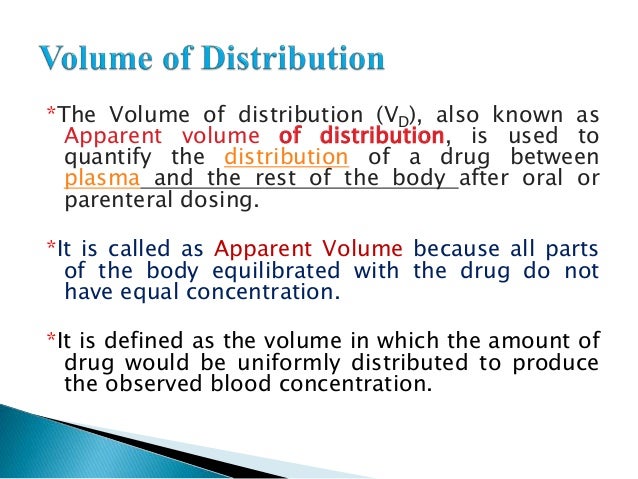

Therefore, binding potentials are defined:īinding potentials are less dependent on these confounding factors, and therefore more directly
Volume of distribution free#
free in tissue ( FT), dissolved in waterīinding and nonspecific binding in tissue. nonspecifically bound to other macromolecular components ( NS), or. In receptor studies, tissue may contain radioligand that is Volumes of distribution are applicable to all PET radiopharmaceutical studies, but mainly used in Then, the tissue-to-plasma ratio equals the total distribution volume of the radioligand. Tissue and out of tissue is the same, and the tissue concentration remains steady.Īll tissue compartments, where the radiotracer can go in, would then be in equilibrium withĪll the other tissue compartments, and also with the plasma compartment. In the tissue, then, if we wait long enough, we achieve a dynamic equilibrium, where the flux into If there is no irreversible uptake of the radiopharmaceutical Lets imagine a theoretical situation, where we keep the concentration of radioligand in plasma Radioligand is being concentrated in tissue by 15:1. Random drug testing is most often employed for detecting usage of drugs of abuse.Therefore, a V T equal to 15 mL To adjust varability among laboratory testing methods for prothrombin time, an international normalized ratio (INR) value is reported. The desired range is a prothrombin time of 2.5 (in a range of 2 to 3) greater than the normal range. Since this drug antagonizes vitamin K dependent coagulation factor synthesis, then the prothrombin time is used to gauge the efficacy of coumadin therapy. The dose is adjusted to maintain the drug level within defined peak and trough ranges.įor coumadin, the desired effect is anticoagulation. Based upon dosing intervals, a peak drug level is measured at a specified time following the last dose, while a trough level is measured at a specified interval before the next dose. The timing of phlebotomy to obtain patient samples is critical in relationship to the timing of drug dosing.įor some antibiotics, such as aminoglycosides, there is risk for renal toxicity and ototoxicity. The very young and older persons may have different levels of metabolism or volume of distribution, so age may play a role in determining proper drug administration. For example, with drugs such as aminoglycoside antibiotics excreted via the kidney, the patient's renal function is important, and a serum creatinine level may be obtained. It may be necessary to determine how a patient's renal or hepatic status may affect drug concentrations. The half-life of the drug and the ability of the body to metabolize or excrete the drug determine the trough (lowest) concentration of drug before the next dose. For oral ingestion, rate of absorption and distribution is important. For injection, this depends upon the volume of distribution of the drug. Depending upon the route of administration, a peak (highest) concentration occurs at an interval following administration. Unless a drug is being administered by continuous infusion, there are variations in concentration depending upon dosing intervals. In general, the ideal range between highest and lowest effective and safe level is the therapeutic range of the drug. If the level is too low, then the drug may not have efficacy. The pharmacologic effect of the drug may depend upon achieving a specific concentration. TDM is employed when clinical findings, such as vital signs, or results of other laboratory testing do not indicate whether an optimal drug concentration has been achieved. 

An underdose or overdose may easily occur and is undesirable. It is desirable that these drug concentrations fall within a narrow therapeutic range. Therapeutic drug monitoring (TDM) is utilized to monitor and adjust drug doses based on measured plasma concentrations. Return to the main menu Therapeutic drug monitoring

Laboratory Medicine Curriculum Clinical Laboratory - Chemical Pathology and Immunology








 0 kommentar(er)
0 kommentar(er)
